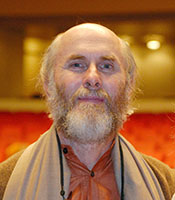The Eternal Tradition
by David Frawley (Vamadeva Shastri)
www.vedanet.com
To understand the higher truth of Yoga, I think it is crucial that we go to the eternal presence, the essence, and the heart of Yoga – not simply to what Yoga may appear to be at a particular point in time, location, or relative to a particular social grouping. Yoga in America or Yoga in the West today is but one incarnation as it were of an ongoing eternal tradition of Yoga that has many faces and a variety of aspects. While modern Yoga today has much to offer, there is also much more that can be added to it, if we look at the subject in a broader context.
Yoga in the deeper sense is our connection with the cosmic reality of the sacred -- however one may name or define it -- of the universal consciousness and being beyond all the boundaries of the human mind and the limitations of human language. That spiritual basis of Yoga should not be forgotten, even when we may be benefitting from other approaches to Yoga.
Yoga teaches us the nature of this supreme reality of consciousness and our intimate relationship with it – which may be our most important relationship in life. Our inner connection to the universal consciousness has ramifications on all levels of our existence of body, prana, senses, mind, and heart, impacting our innermost consciousness and our inner being that few of us have fully accessed and which our civilization as a whole has not yet entirely fathomed. Our yogic connection to the universe as a whole extends beyond any single incarnation of our soul or any particular state of human culture.
Perhaps more significantly, Yoga provides us with the transformative tools that we can use to approach this supreme reality—extending from practices of asana (posture) and pranayama (breathing techniques), to visualization, mantra (sound) and meditation—so that we can experience it directly for ourselves. Yoga’s practicability and accessibility appeal to the modern mind that is not interested in dogmas or assertions and prefers individual experience and realization.
My personal study and practice of Yoga began over four decades ago with the Raja Yoga traditions of Paramahansa Yogananda, Sri Aurobindo, and Ramana Maharshi, and I was later able to meet with senior teachers in these traditions. This probably provided me a greater spiritual vision of Yoga than had I come to Yoga from asana as the starting point.
My studies led me to learn Sanskrit, the language of Yoga, and to study, translate and comment on the Vedas, Upanishads and Yoga Shastras. It was part of extensive work, travel and study in India where I met with many Yogis and discovered a number of Yoga teachings not yet known in the West. It included a detailed examination of Mantra Yoga, perhaps the most common tool in all of Yoga’s branches, and learning to access the great deities of Yoga, particularly Shiva and Shakti as the great Cosmic Masculine and Feminine powers.
Such broad associations allowed me to learn other aspects of what I would call the “Greater Yoga Tradition,” including Vedantic philosophy, Ayurvedic medicine, and Vedic astrology, which bring in additional dimensions for the application of Yoga. I see Yoga as an integral part of related Vedic teachings that help us to understand the manifold currents of awareness of the cosmic life.
My work in both the West and in India allowed me to teach and do programs at many Yoga centers and ashrams in the U.S., as well as in major Yoga centers and ashrams throughout India. I learned how Yoga in the East was often different from Yoga in the West and has its own influences and challenges.
I found the role of Ayurveda relative to Yoga therapy and yogic healing to be particularly important. Ayurveda provides us with a complete system of yogic healing, extending from determination of individual constitution or mind-body type, to an understanding of the disease process and diagnosis, to treatment measures of diet, herbs, bodywork, clinical practices and life-style routines. Ayurveda shows us how to bring the principles and practices of Yoga into our daily lives as part of a system of natural living and higher consciousness.
 Acharya David Frawley (Pandit Vamadeva Shastri) is the author of more than 30 books on vedic subjects published in 20 languages over the last 30 years, including original translations from the Vedas and authoritative texts on Yoga, Vedanta, Ayurveda and vedic astrology. His work is widely respected in India, where he is honored as a Vedacharya or master of the vedic teachings as well as an ayurvedic doctor (vaidya). His teachings help serve as a bridge to integrate the different profound fields of vedic and yogic knowledge in a modern setting. He is the director of the American Institute of Vedic Studies (www.vedanet.com). Acharya David Frawley (Pandit Vamadeva Shastri) is the author of more than 30 books on vedic subjects published in 20 languages over the last 30 years, including original translations from the Vedas and authoritative texts on Yoga, Vedanta, Ayurveda and vedic astrology. His work is widely respected in India, where he is honored as a Vedacharya or master of the vedic teachings as well as an ayurvedic doctor (vaidya). His teachings help serve as a bridge to integrate the different profound fields of vedic and yogic knowledge in a modern setting. He is the director of the American Institute of Vedic Studies (www.vedanet.com). |